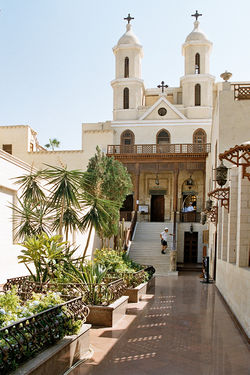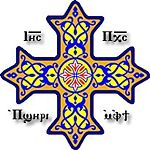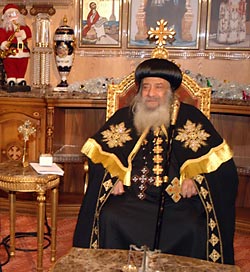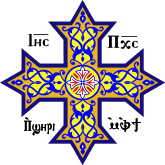From Wikipedia, the free encyclopedia
|
A Copt (Coptic: ou.Remenkīmi en.Ekhristianos, literally: Egyptian Christian) is a native Egyptian Christian. Today, more than 95% of the Copts belong to the Coptic Orthodox Church of Alexandria. The remaining (around 500,000) are divided between the Coptic Catholic and the Coptic Protestant churches. The Copts are by far the largest Christian community in North Africa and the Middle East. The word "Coptic" was originally used in Classical Arabic to refer to Egyptians in general (see etymology section), but it has undergone semantic shift over the centuries to mean more specifically Egyptian Christian after the bulk of the Egyptian population converted to Islam. In modern usage, it is frequently applied to members of the Coptic Orthodox Church irrespective of ethnic origin. Thus Ethiopian and Eritrean Christians (and Nubians before their conversion to Islam) were traditionally referred to as Copts, though this has been falling out of use since their Tewahedo Churches were granted their own patriarchs.
The number of Copts in Egypt has been subject to some controversy. Coptic sources put forward figures ranging from 14% to 20% (between 10 and 15 million), but the Egyptian government insists that Copts represent about 6% (5 million) of the Egyptian population. Part of the controversy could be attributed to the increasing number of Copts born outside Egypt and who do not carry Egyptian passports. The number of Copts within Egypt may be very slowly declining due to higher emigration rates caused by harassment and discrimination at the hands of Islamist militants and the Egyptian government. Egyptian Copts have occasionally been on the receiving end of violent acts from Islamic extremist groups. Copts have leveled the accusation that the Egyptian government has sometimes been complicit or uncaring in the face of such incidents.[The 2006 World Factbook estimates that 7.6 million or 10% of Egyptians are Christian (9% Coptic and 1% other denominations).
Etymology
The English word Copt is from New Latin Coptus, which is derived from Arabic qubṭi قبطي (pl: qubṭ قبط and aqbāṭ أقباط), an Arabisation of the Coptic word kubti (Bohairic) and/or kuptaion (Sahidic). This word is in turn derived from the Greek word Αἰγύπτιος, aiguptios: "Egyptian", from Αἴγυπτος, aiguptos: "Egypt".
|
Hut-ka-Ptah in hieroglyphs |
|||||||
|
The Greek term for "Egypt" has a long history. It goes back to the Mycenaean language (an early form of Greek) where the word a3-ku-pi-ti-jo (lit. "Egyptian"; used here as a man's name) was written in Linear B. This Mycenaean form is likely from Egyptian ḥwt-k3-ptḥ ("Hut-ka-Ptah"), literally "Estate (or 'House') of Ptah" (cf. Akkadian āluḫi-ku-up-ta-aḫ), the name of the temple complex of the god Ptah at Memphis. As the chief temple precinct of the capital of Egypt, the name was applied to the entire city of Memphis and ultimately to the country as a whole.
A similar situation is observed in the name Memphis [Greek Μέμφις], which comes from the Egyptian name of the pyramid complex of king Pepi II, mn nfr ppy (lit. "Established in Perfection or 'Beauty' is Pepy") at Saqqara but which was applied to the nearby capital city. Interestingly, this usage survived in Sahidic as Gupton and Kupton, meaning "Memphis". In modern Egyptian Arabic, Cairo is usually called Masr (Egyptian Arabic: مَصر), which is also the name of Egypt.
There is another theory which states that the Arabic word qibṭ "Copt" was an Arabisation of the Greek name of the town of Κόπτος Coptos (modern قفط Qifṭ; Coptic Kebt and Keft), but is generally no longer accepted.
References to Copts in the Coptic language are both Greek and Coptic in origin. The words kuptaion (Sahidic) and kubti (Bohairic) are attested, but are used in the surviving texts to refer to the language, rather than the people; these both derive from Greek Αἴγύπτιος aiguptios "Egyptian". The Coptic term for the word "Egyptian" is rem en kēme (Sahidic), lem en kēmi (Fayyumic), rem en khēmi (Bohairic) etc., literally "people of Egypt"; cf. Egyptian rmṯ n kmt, Demotic rmt n kmỉ.
The etymological meaning of the word therefore pertains to all people of Egyptian origins, not only those who profess Coptic Orthodoxy. Medieval writers before the Mamluk period often used the words Copts (Arabic: قبط) and Egyptians (Arabic: مصريون) interchangeably to describe all the people of Egypt whether Christian or Muslim. After the bulk of the Egyptian population converted to Islam, the word Copt came to be associated with Egyptians who retained their Christianity. In the 20th century, some Egyptian nationalists and intellectuals began using the term Copts in the historical sense. For example, Markos Pasha Semeika, founder of the Coptic Museum, addressed a group of Egyptian students in these words: "All of you are Copts. Some of you are Muslim Copts, others are Christian Copts, but all of you are descended from the Ancient Egyptians".
History
-
Main article: Coptic Orthodox Church of Alexandria

The Copts are one of the oldest Christian communities in the Middle East. Although integrated in the larger Egyptian nation, the Copts have survived as a distinct religious community forming today between 10 and 20 percent of the native population. They pride themselves on the apostolicity of the Egyptian Church whose founder was the first in an unbroken chain of patriarchs.
Foundation of the Egyptian Christian Church
According to ancient tradition, Christianity was introduced to the Egyptians by Saint Mark in Alexandria, shortly after the ascension of Christ and during the reign of the Roman emperor Claudius around 42 A.D. The legacy that Saint Mark left in Egypt was a considerable Christian community in Alexandria. From Alexandria, Christianity spread throughout Egypt within half a century of Saint Mark's arrival in Alexandria, as is clear from a fragment of the Gospel of John, written in Coptic, which was found in Upper Egypt and can be dated to the first half of the second century, and the New Testament writings found in Oxyrhynchus, in Middle Egypt, which date around the year 200 A.D. In the second century, Christianity began to spread to the rural areas, and scriptures were translated into the local language, today known as the Coptic language (which was called the Egyptian language at the time). By the beginning of the 3rd century A.D., Christians constituted the majority of Egypt’s population, and the Church of Alexandria was recognized as one of Christendom's four Apostolic Sees, second in honor only to the Church of Rome.The Church of Alexandria is therefore the oldest church in Africa.
Contributions to Christianity
The Egyptians contributed immensely to the formation of the worldwide Christian mind. To name a few examples, the Catechetical School of Alexandria was the oldest catechetical school in the world. Founded around 190 A.D. by the scholar Pantanaeus, the school of Alexandria became an important institution of religious learning, where students were taught by scholars such as Athenagoras, Clement, Didymus, and the great Origen, who was considered the father of theology and who was also active in the field of commentary and comparative Biblical studies. However, the scope of this school was not limited to theological subjects; science, mathematics and humanities were also taught there. The question-and-answer method of commentary began there, and 15 centuries before Braille, wood-carving techniques were in use there by blind scholars to read and write.
Another major contribution made by the Egyptians to Christianity was the creation and organization of monasticism. The most prominent figures of the monastic movement were Anthony the Great, Paul of Thebes, Macarius the Great, Shenouda the Archimandrite and Pachomius the Cenobite. By the end of the fifth century, there were hundreds of monasteries, and thousands of cells and caves scattered throughout the Egyptian desert. Worldwide Christian monasticism stems, either directly or indirectly, from the Egyptian example. Thus, Saint Basil the Great Archbishop of Caesarea Mazaca, and the founder and organiser of the monastic movement in Asia Minor, visited Egypt around 357 A.D. and his monastic rules are followed by the Eastern Orthodox Churches; Saint Jerome, who translated the Bible into Latin, came to Egypt while en route to Jerusalem around 400 A.D. and left details of his experiences in his letters; and Saint Benedict founded the Benedictine Order in the sixth century on the model of Saint Pachomius, although in a stricter form. Countless pilgrims have visited the Egyptian Desert Fathers to emulate their spiritual, disciplined lives.
The Ecumenical Councils
The Egyptians also played a major role in the first three Ecumenical councils. Thus, the Council of Nicaea (325 AD) was presided over by Pope Alexander of Alexandria, along with Saint Hosius of Córdoba. In addition, the most prominent figure of the council was the future Pope of Alexandria Athanasius, who played the major role in the formulation of the Nicene Creed, recited today in all Christian churches of different denominations. One of the council's decisions was to entrust the Pope of Alexandria with calculating and annually announcing the exact date of Easter to the rest of the Christian churches. The Council of Constantinople (381 AD) was presided over by Pope Timothy of Alexandria, while the Council of Ephesus (431 AD) was presided over by Pope Cyril of Alexandria. Undoubtedly, the fact that the first three Ecumenical councils in the history of Christianity were headed by Egyptian patriarchs attested to the major contributions that the See of Alexandria has contributed to the establishment of early Christian theology and dogma.
Council of Chalcedon
In 451 A.D., following the Council of Chalcedon, the Church of Alexandria was divided into two branches. Those who accepted the terms of the Council became known as Chalcedonies or Melkites. Those who did not abide by the Council's terms were labeled non-Chalcedonies or Monophysites (and later Jacobites after Jacob Baradaeus). The non-Chalcedonies, however, rejected the term Monophysites as erroneous and insisted on being called Miaphysites. The majority of the Egyptians belonged to the Miaphysite branch, which led to their persecution by the Byzantines in Egypt.
The Arab-Muslim Invasion of Egypt
In 641 A.D., Egypt was invaded by the Arabs who faced off with the Byzantine army, but found little to no resistance from the native Egyptian population. Local resistance by the Egyptians however began to materialize shortly thereafter and would last until at least the ninth century.Examples include the Revolt of the Beshmorites, a large-scale national resistance staged in the mid-eighth century in the Nile Delta. It was crushed by Marwan II, the Umayyad caliph. The last large-scale armed resistance of the Egyptians against the Arabs was towards the mid ninth century, which was brutally crushed by Al-Ma'mun, the Abbasid caliph. Local resistances against the Arabs and the Muslims remained through the 12th century, such as the 1176 revolt of the Christian inhabitants of Qift, which was promptly suppressed by Al-Adil, brother of Saladin, who hanged nearly 3000 Copts on the trees around the city.
The Arabs imposed a special tax, known as Jizya, on the Christians who acquired the status of dhimmis, and all native Egyptians were prohibited from joining the army. Egyptian converts to Islam in turn were relegated to the status of mawali. Heavy taxation was one of the reasons behind Egyptian organized resistance against the new occupying power, as well as the decline of the number of Christians in Egypt.

The Arabs in the 7th century seldom used the term Egyptian, and used instead the term Copt to describe the people of Egypt. Thus, Egyptians became known as Copts, and the non-Chalcedonian Egyptian Church became known as the Coptic Church. The Chalcedonian Church remained known as the Melkite Church. In their own native language, Egyptians referred to themselves as rem-en-kimi, which translates into those of Egypt. Religious life remained largely undisturbed following the Arab occupation, as evidence by the rich output of Coptic arts in monastic centers in Old Cairo (Fustat) and throughout Egypt. Conditions, however, worsened shortly after that, and in the eighth and ninth centuries, during the period of the great national resistance against the Arabs, Muslim rulers banned the use of human forms in art (taking advantage of an iconoclastic conflict in Byzantium) and consequently destroyed many Coptic paintings and frescoes in churches.
The Fatimid period of Islamic rule in Egypt was tolerant with the exception of the violent persecutions of caliph Al-Hakim. The Fatimid rulers employed Copts in the government and participated in Coptic and local Egyptian feasts. Major renovation and reconstruction of churches and monasteries were also undertaken. Coptic arts flourished, reaching new heights in Middle and Upper Egypt.Persecution of Egyptian Christians, however, reached a peak in the early Mamluk period following the Crusader wars. Many forced conversions of Christians took place. Monasteries were occasionally raided and destroyed by marauding Bedouin, but were rebuilt and reopened.
Copts in modern Egypt
The position of the Copts did not begin to improve until the rule of Muhammad Ali in the early 19th century, who abolished the Jizya and allowed Egyptians (Copts as well as Muslims) to enroll in the army. Conditions continued to improve throughout the nineteenth century under the leadership of the great reformer Pope Cyril IV, and in the first half of the twentieth century (known as the Golden Age by the Copts) during Egypt's liberal period. Copts participated in the Egyptian national movement for independence and occupied many influential positions. Two significant cultural achievements include the founding of the Coptic Museum in 1910 and the Higher Institute of Coptic Studies in 1954. Some prominent Coptic thinkers from this period are Salama Moussa, Louis Awad and Secretary General of the Wafd Party Makram Ebeid. Following the 1952 coup d'état by the Free Officers, the conditions of the Copts have been slowly deteriorating and their human rights are often violated.
Today, members of the non-Chalcedonian Coptic Orthodox Church constitute the majority of the Egyptian Christian population. Mainly through emigration and partly through European, American, and other missionary work and conversions, the Egyptian Christian community now also includes other Christian denominations such as Protestants (known in Arabic as Evangelicals), Roman and Eastern Rite Catholics, and other Orthodox congregations. The term Coptic remains exclusive however to the Egyptian natives, as opposed to the Christians of non-Egyptian origins. Some Protestant churches for instance are called "Coptic Evangelical Church", thus helping differentiate their native Egyptian congregations from churches attended by non-Egyptian immigrant communities such as Europeans or Americans.
In 2005 a group of Coptic activists created a flag to represent Copts worldwide. This flag is not officially recognized by the Coptic Orthodox Church of Alexandria.
Human rights
The religious freedom of Egypt's Coptic community is hampered to varying degrees by extremist Islamist groups and by discriminatory and restrictive government policies. Copts have faced increasing marginalization after the 1952 coup d'état led by Gamal Abdel Nasser. Until recently, Christians were required to obtain presidential approval for even minor repairs in churches. Although the law was eased in 2005 by handing down the authority of approval to the governors, Copts continue to face many obstacles in building new or repairing existing churches. These obstacles are not found in building mosques.
Boutros Boutros-Ghali is a Copt who served as Egypt's acting foreign minister twice under President Anwar Sadat (1977 and 1978 - 1979).Although Boutros Boutros-Ghali later became the United Nations Secretary-General, his appointment as an only acting foreign minister depicted Egypt's systematic elimination of Copts from all governmental influential positions. Today, only two Copts are on Egypt's governmental cabinet: Finance Minister Youssef Boutros Ghali and Environment Minister Magued George. There is also currently one Coptic governor out of 25, that of the Upper Egyptian governorate of Qena, and the first Coptic governor in a few decades. In addition, Naguib Sawiris, an extremely successful businessman and one of the world's 100 wealthiest people, is a Copt. In 2002, under the Mubarak government, Coptic Christmas (January 7) was recognized as an official holiday. Nevertheless, the Coptic community has occasionally been the target of hate crimes and physical assaults. The most significant was the 2000-2001 El Kosheh attacks, in which 21 Copts and 1 Muslim were killed. A 2006 attack on three churches in Alexandria left one dead and 17 injured. In addition, many Copts continue to complain of being minimally represented in law enforcement, state security and public office, and of being discriminated against in the workforce on the basis of their religion.
Freedom of religion is guaranteed by the Egyptian constitution, and Egyptians who convert to Islam face no complications. However, Egyptians converting from Islam to Christianity or any other religion face great troubles with the government including arrest and being tortured by the National Security "Amn El-Dawla" officers to force them to deny their new faith, as the Coptic file is considered, by the governmental authorities, a national security issue. Public officials, being conservative themselves, intensify the complexity of the legal procedures required to recognize the religion change as required by law. Security agencies claim that such conversions from Islam to Christianity may stir social unrest, and therefore take steps to prevent it from happening sometimes by detaining the subjects.
Language
-
Main article: Coptic language
The Coptic language is the last stage of the Egyptian language.
Coptic should more correctly be used to refer to the script rather than the language itself. Even though this script was introduced as far back as the 1st century BC, it is usually applied to the writing of the Egyptian language from the first century AD to the present day.
Today, Coptic is the liturgical language of the Egyptian Church and is also taught in Egypt and worldwide in many prestigious institutions.
Dialects of Coptic language:
- Sahidic: Theban or Upper Egyptian.
- Bohairic: The dialect of the Nile Delta and of the medieval and modern Coptic Church.
- Akhmimic
- Lycopolitan (also known as Subakhmimic)
- Fayyumic
- Oxyrhynchite
Calendar
-
Main article: Coptic calendar
The Coptic calendar, also called the Alexandrian calendar, is used by the Coptic Orthodox Church and also by Ethiopia as its official calendar (with different names). This calendar is based on the ancient Egyptian calendar. To avoid the calendar creep of the latter, a reform of the ancient Egyptian calendar was introduced at the time of Ptolemy III (Decree of Canopus, in 238 BC) which consisted of the intercalation of a sixth epagomenal day every fourth year. However, this reform was opposed by the Egyptian priests, and the idea was not adopted until 25 BC, when the Roman Emperor Augustus formally reformed the calendar of Egypt, keeping it forever synchronized with the newly introduced Julian calendar. To distinguish it from the Ancient Egyptian calendar, which remained in use by some astronomers until medieval times, this reformed calendar is known as the Coptic calendar. Its years and months coincide with those of the Ethiopian calendar but have different numbers and names.
Coptic year

The Coptic year is the extension of the ancient Egyptian civil year, retaining its subdivision into the three seasons, four months each. The three seasons are commemorated by special prayers in the Coptic Liturgy. This calendar is still in use all over Egypt by farmers to keep track of the various agricultural seasons. The Coptic calendar has 13 months, 12 of 30 days each and an intercalary month at the end of the year of 5 or 6 days, depending whether the year is a leap year or not. The year starts on 29 August in the Julian Calendar or on the 30th in the year before (Julian) Leap Years. The Coptic Leap Year follows the same rules as the Julian Calendar so that the extra month always has six days in the year before a Julian Leap Year.
The Feast of Neyrouz marks the first day of the Coptic year. Its celebration falls on the 1st day of the month of Thout, the first month of the Coptic year, which for AD 1901 to 2098 usually coincides with 11 September, except before a Gregorian leap year when it's September 12. Coptic years are counted from AD 284, the year Diocletian became Roman Emperor, whose reign was marked by tortures and mass executions of Christians, especially in Egypt. Hence, the Coptic year is identified by the abbreviation A.M. (for Anno Martyrum or "Year of the Martyrs"). The A.M. abbreviation is also used for the unrelated Jewish year (Anno Mundi).
Every fourth Coptic year is a leap year without exception, as in the Julian calendar, so the above mentioned new year dates apply only between AD 1900 and 2099 inclusive in the Gregorian Calendar. In the Julian Calendar, the new year is always 29 August, except before a Julian leap year when it's August 30. Easter is reckoned by the Julian Calendar in the Old Calendarist way.
To obtain the Coptic year number, subtract from the Julian year number either 283 (before the Julian new year) or 284 (after it).
The Head of the Copt's Orthodox : Pope Shenouda III of Alexandria
| H.H. Pope Shenouda III
of Alexandria (born 3 August 1923), born Nazeer Gayed
(Arabic: نظير جيد), is the 117th Pope of Alexandria and the
Patriarch of All Africa on the Holy Apostolic See of Saint Mark the
Evangelist of the Coptic Orthodox Church of Alexandria. By definition of his post he is the head of The Holy Synod of the Coptic Orthodox Patriarchate of Alexandria. A graduate of Cairo University and the Coptic Orthodox Seminary, Nazeer Gayed became a monk under the name Fr. Antonius the Syrian after joining the Syrian Monastery of the Ever-Virgin Mary the Theotokos, where he was later elevated to the priesthood. |
 |
H.H. Pope Cyril VI summoned Fr. Antonios to the patriarchate where he ordained him Bishop of Christian Education and Dean of the Coptic Orthodox Theological University, whereupon he assumed the name Shenouda, which was the name of a Coptic Saint and two previous Popes: Shenouda I (859- 880) and Shenouda II (1047–1077).
He has served as Pope of Alexandria since November 14, 1971, presiding over a worldwide expansion of the Coptic Orthodox Church. During his papacy, Pope Shenouda III has appointed the first-ever Bishops to preside over North American dioceses that now contain over one hundred Churches, up from four in 1971, as well as the first Bishops in Australia and the first Coptic Churches in South America.
He is known for his commitment to Christian unity and has, since the 1970s, advocated inter-denominational Christian dialogue.
Prominent Copts
-
Main article: List of prominent Copts
Many Copts are internationally renowned. Some of the most well known Copts include Boutros Boutros-Ghali the sixth Secretary-General of the United Nations, Sir Magdi Yacoub an internationally renowned heart surgeon, Hani Azer, a world leading civil engineer, and billionaire Fayez Sarofim, one of the richest men in America and the world.
